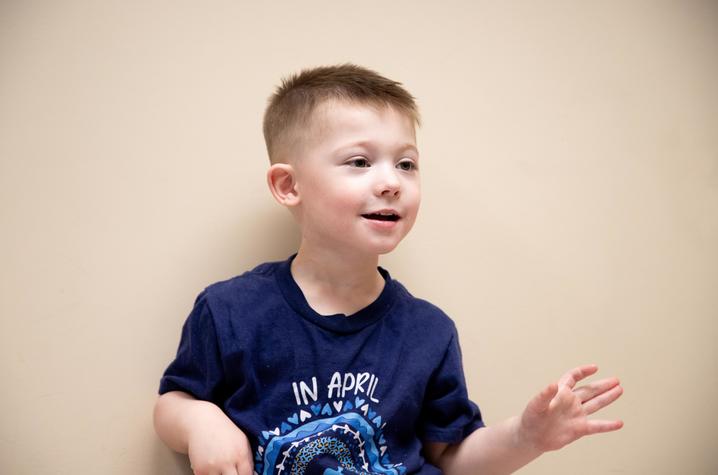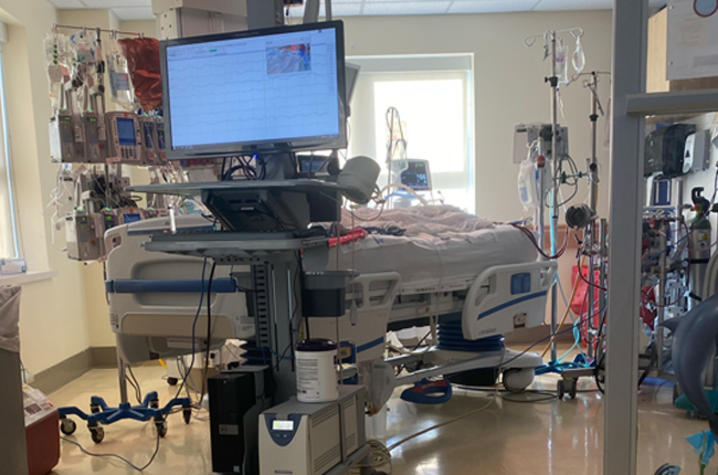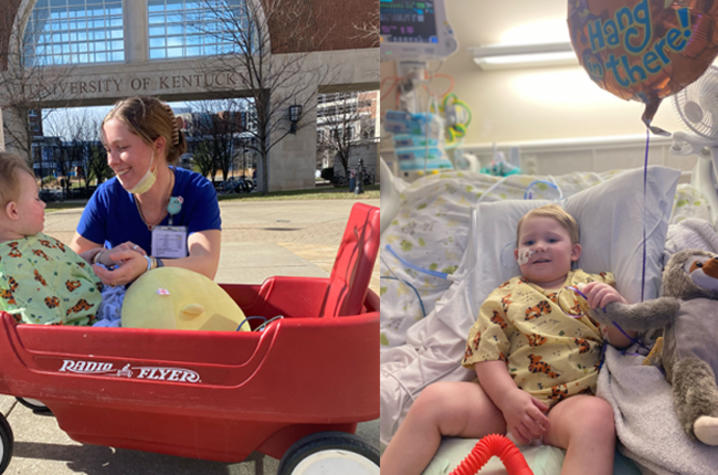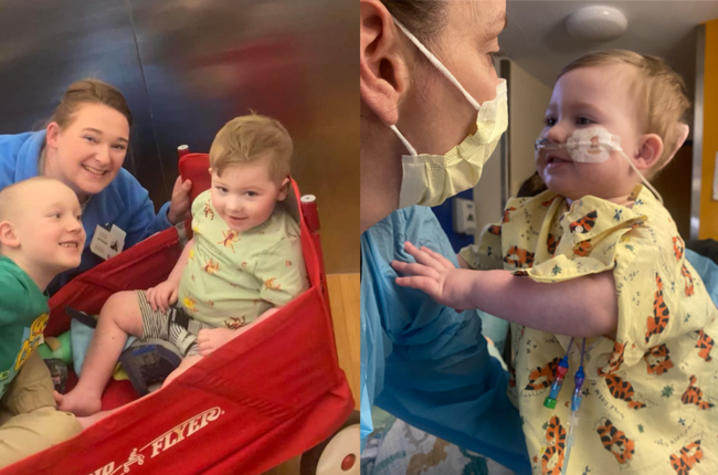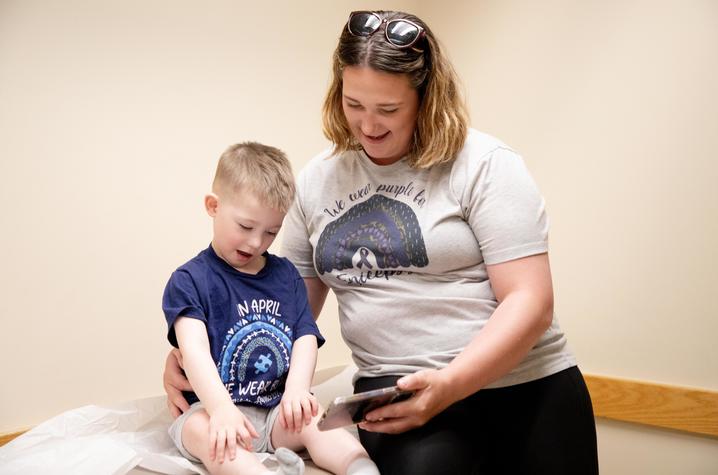Fighting to live — young patient defies odds after rare complication
LEXINGTON, Ky. (June 24, 2024) – Easton Hutchins has his own unique way of spending holidays.
The 3-year-old from Berea spent his first and second birthdays, Christmas and Easter in the pediatric intensive care unit (PICU) at Kentucky Children’s Hospital (KCH). His mother Tabbitha jokes about how she doesn’t know when Easton knows a major holiday or event is coming up, but he never fails to honor the occasion with a trip to the hospital.
At six months old, Easton was diagnosed with a rare form of epilepsy called Dravet Syndrome. With Dravet, high temperatures trigger severe, prolonged seizures. These seizures can lead to developmental delays; Easton was tracking behind his physical age in terms of abilities and cognitive function. But nevertheless, he adored being outside and chasing after his familiy’s chickens.
On Dec. 10, 2022 — his older brother’s birthday — Tabbitha noticed Easton’s breathing was slow. Erring on the side of caution, Tabbitha and her husband Jacob brought him to KCH. As Easton’s seizures can often lead to prolonged hospital stays, the Hutchins know the staff of KCH and the routine of Easton’s treatment very well. But this wasn’t one of Easton’s typical seizures. This was something different.
Easton’s oxygen rate was very low; he was given breathing treatments throughout the night, every 30 minutes. The next morning, as Tabbitha fed Easton his bottle, she watched his face turn blue.
“I ran up and pressed the button on the wall, and before I knew it, there were probably 40 doctors and nurses in the room,” Tabbitha said. “I don’t know where they all came from, but they were there in a blink of an eye.”
As a mother of a child with a rare seizure disorder, Tabbitha knows more than most about hospitals and critical care units. But for the first time, she and Jacob were asked to leave Easton’s room. Worry escalated to panic as they waited in a family room outside the PICU. Panic gave way to abject terror when they heard a flurry of commotion and calls for the hallway to clear.
“My heart dropped,” Tabbitha said. “I just knew.”
She threw open the door just in time to see countless doctors and nurses rushing Easton’s motionless little body down the hall. Scott Studeny, M.D., attending physician in the PICU who had gotten to know the Hutchins during Easton’s previous stays, came in and explained to Tabbitha and Jacob that Easton wasn’t getting oxygen. Attempts to restore his breathing with a ventilator weren’t successful.
The source of Easton’s ordeal was the human metapneumovirus, a seasonal virus like RSV that can lead to upper and lower respiratory disease in young children. Easton’s condition progressed to pediatric acute respiratory distress syndrome (PARDS), a condition in which lungs already infected and inflamed fill with fluid. PARDS is rare, affecting fewer than 4% of patients already admitted to the hospital with a respiratory condition; worse still, it carries a mortality rate of 20-25%.
‘It felt like watching TV, but it was so real.’
“Dr. Studeny came up to me, put both hands on my shoulders, and said, ‘Tabbitha, I promise you, I’m doing everything in my power to take care of your son,’” she said. “He was super calm. He explained that Easton had been without oxygen for about an hour, maybe longer.” Studeny gave the Hutchins two options, one of which was extracorporeal membrane oxygenation, or ECMO.
Often referred to as a full heart and lung support machine, ECMO is an advanced, ECMO is an advanced life support system in which blood is circulated and oxygenated outside the body. Blood flows from the right side of the heart to the membrane oxygenator in the machine, then is rewarmed and sent back to the body. This gives the heart and lungs the chance to rest and heal. According to Studeny, the use of ECMO on pediatric patients at KCH is infrequent; he estimates about five to seven cases per year.
Tabbitha says her only knowledge of ECMO came from the television show “Grey’s Anatomy,” but Studeny explained the whole process, step by step, along with the potential for risks and complications. Hours passed before he came back, reporting that Easton was doing well and that the ECMO was doing its job.
“He prepared us,” said Tabbitha. “He said it was going to be very scary seeing Easton like this. We’ve seen Easton intubated plenty of times before, but walking into the room threw me for a loop. Never in my life have I seen that many tubes and wires coming out of not just my child, but any child. It felt like watching TV, but it was so real.”
While Tabbitha and Jacob trusted Easton’s care team, Easton seemed to be getting worse. Tabbitha prayed and tried to stay strong for Easton, but in the dark recesses of her mind, a quiet voice was telling her there was a chance that he might not make it out of this. She had fleeting thoughts of having to plan a funeral and how to tell her other son that his brother might not be coming home. Tabbitha and Jacob had hours of honest, open discussions about Easton’s future.
“I’m a firm believer in just telling parents and families the truth about what’s going on with their kid,” said Studeny. “It’s hard enough to have your child in the PICU and be sick enough to need ECMO. You don’t want to sugarcoat and give false hope, but I’d much rather be honest with them, and the kid pulls through and the parents can look at me and say, ‘You were wrong.’”
After long discussions with Easton’s care team about his future, Tabbitha instituted a new policy: no more talks of death.
“I told everyone, we’re not talking about death in this room,” she said. “No more negativity. Easton can hear you. His heart is beating, his lungs are breathing. Every vital sign is working. We’re going to speak live for Easton.”
After six days, discussions were held to determine whether Easton should come off ECMO. A system like ECMO can be a double-edged sword; while the lungs are healing and getting stronger, the rest of the body can deteriorate. And once Easton was removed from ECMO, there was no putting him back on.
“They told me it was now or never,” Tabbitha said. “We accepted that if this didn’t work out, we knew where Easton was going, and that one day we would see him. He would be with God and be completely pain-free, never have a seizure again, never have to see tubes, wires or needles ever again. So, we agreed.”
“We choose to go into pediatric critical care because of our passion, and we get training on how to talk to families, but it never gets any easier,” said Studeny. “I’ve got kids of my own, and I would want the full truth. Sometimes it’s hard to be as straightforward as possible without making it worse.”
Easton was removed from ECMO, and his oxygen levels held. The system had done its job; the few days Easton’s lungs had to rest were enough to allow them to sufficiently move oxygenated blood through his body. Tabbitha says she and the family “spoke life” — and Easton heard them.
'There was no time.’
But there was a complication. Shortly after being removed from ECMO, Jacob noticed Easton’s abdomen was swelling. Air had become trapped in his small intestine, a condition called pneumatosis intestinalis (PI). Studeny and his team were caught off guard, as PI more commonly occurs in older children with compromised immune systems. Easton’s oxygen levels were good, he didn’t have any signs or symptoms of the infection that usually precedes the telltale abdominal swelling.
The PICU team had to act quickly to relieve the pressure. Informed that Easton was quickly deteriorating, pediatric surgeon Danielle Walsh, M.D., went straight to his room, reviewing his X-rays on her phone on the way. She knew the situation was dire and called to have the operating room prepped and ready for emergency surgery.
But when she saw Easton, she made a quick decision — his condition was so dire that there was not even time to transport him to an OR. Walsh had to perform the necessary lifesaving procedure right there in Easton’s room.
“He was arresting,” said Walsh. “He was blue because his belly was so tight that his lungs couldn’t expand. A decision was made to immediately open his belly at the bedside. Mom was as calm as any mom could be under those circumstances.”
Within two minutes, the PICU nurses gathered the basic supplies Walsh needed to do the surgery right there in Easton’s room.
“As we rapidly opened him to relieve the belly pressure, the whole team was in sync and describing what was needed and what was happening,” said Walsh.
Within 30 seconds of opening, his oxygen levels began to rise. After three minutes, he was pink and stabilizing. Ten minutes after that, Easton could safely be moved to the operating room for the surgery to remove portions of the bowel that contributed to the PI.
“Easton showed his determination to live once again and continued improving over serial procedures until we could put his intestines back together and close the belly wall over it,” said Walsh.
Emergency measures of this nature are rare; in his pediatric critical care career, Studeny can recall fewer than five such instances.
The long road home
After the surgery, Easton slowly recovered. He left the PICU for the progressive care unit, before being discharged to Cincinnati Children’s Hospital Medical Center for additional rehabilitation. After one or two more twists on his road to recovery, he was home for good in early April, four months after being admitted.
While Tabbitha and Jacob were thrilled to have Easton home, they noticed some changes. Easton’s Dravet came with some developmental delays, but he seemed to regress in some of his abilities. He no longer chased after chickens. In fact, he didn’t seem to care whether he was inside or outside.
Studeny suspects post-intensive care syndrome, an assortment of physical, emotional and mental symptoms that persist after a long ICU stay. The syndrome is well documented in adults, but only recently has been studied in children. Easton is in therapy four days a week regaining his physical and occupational skills.
A year after his ordeal, Easton continues to make strides in his recovery. Aside from one overnight stay at KCH, he hasn’t had any major medical scares or spent a holiday in the hospital. Studeny attributes Easton’s recovery to the extraordinary teamwork of nurses, respiratory therapists, physical and occupational therapists. But the real heroes, he says, are Easton’s strong, loving family.
“To see the amount of support he had, the strength they showed through it all when he was at his worst, it was just incredible,” Studeny said. “He’s lucky to have them. It was an honor they let us take care of him.”
UK HealthCare is the hospitals and clinics of the University of Kentucky. But it is so much more. It is more than 10,000 dedicated health care professionals committed to providing advanced subspecialty care for the most critically injured and ill patients from the Commonwealth and beyond. It also is the home of the state’s only National Cancer Institute (NCI)-designated Comprehensive Cancer Center, a Level IV Neonatal Intensive Care Unit that cares for the tiniest and sickest newborns and the region’s only Level 1 trauma center.
As an academic research institution, we are continuously pursuing the next generation of cures, treatments, protocols and policies. Our discoveries have the potential to change what’s medically possible within our lifetimes. Our educators and thought leaders are transforming the health care landscape as our six health professions colleges teach the next generation of doctors, nurses, pharmacists and other health care professionals, spreading the highest standards of care. UK HealthCare is the power of advanced medicine committed to creating a healthier Kentucky, now and for generations to come.





